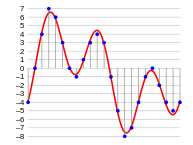Welcome to the second part in my series on digital audio. Today's post will discuss the term bit depth, in relation to PCM audio. For this post, let's assume our example from the previous Primer on Sample Rate, in which we used CD audio: 44.1khz, 16 bit.
The term bit depth relates directly to sample rate. More than likely, in your audio setup, you will see various options for sample rate and bit depth. An example would be 44.1khz (sample rate) and 16 bit (bit depth) as mentioned above. If you recall from my previous Digital Audio Primer blog post, the sample rate is simply the number of times that a digital "copy" or "snap-shot" is taken of the analog signal during the ADC (analog to digital) process. The only data that is captured and stored during this "copy" or "snap-shot" process is the waveform's amplitude, which is stored as a digital string of numbers. This digital string of numbers represents a fixed number of points on that waveform that is "copied". This fixed number is called the bit depth. Therefore, the more points that are sampled, the more robust and complete that waveform "snap-shot" will be.
Bit depth defines the "resolution" of the sample. The more dots to represent the waveform, the better the ability of the DAC (digital to analog converter) to replicate the signal on playback. The picture above shows what a 4-bit sample looks like (every 4 dots is one sample). In the case of 16 bit audio, such as our example of CD audio, there are 65,536 total dots available to make the sample "snap-shot". Therefore again, the more dots, the better the sound.
Bit depth also defines the SNR (signal to noise ratio) which isn't something we will not go into in this blog post, but essentially the higher the bit depth, the lower and lower the noise floor goes and the more signal there is vs. noise. Bit depth also defines the dynamic range of the signal, meaning the range of the quietest sound vs. the loudest sound that can be captured. Therefore in theory, the higher the bit depth, the better and better the sound, and the lower the bit depth the lower quality the sound.
So for podcasting, I recommend recording your interviews at the standard, CD values of 44.1khz, 16 bit, using PCM (or .wav or .aif). These values give you more than enough quality on your recordings and keep the filesize within reasonable sizes. More on PCM and compression formats on an upcoming blog post.
If you have any questions on sample rate, bit depth or any audio question, or if you need help with your podcasting audio setup, please use the "Contact Us" here on this website, or contact me directly at tom@knvpstudios.com. If you are interested in starting up your own podcast, but need help with the technical aspects I can help with that as well.



